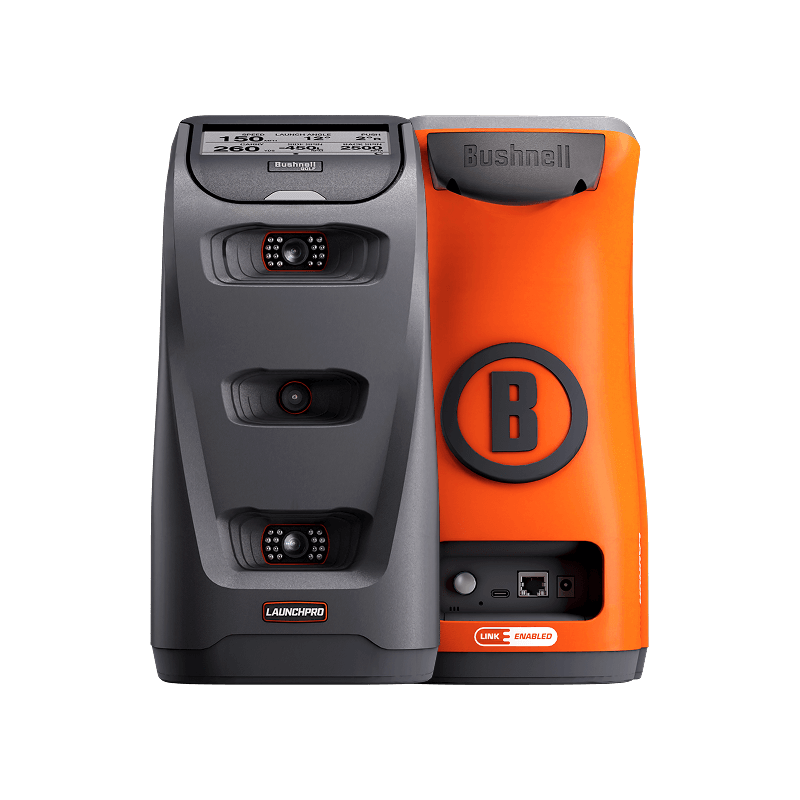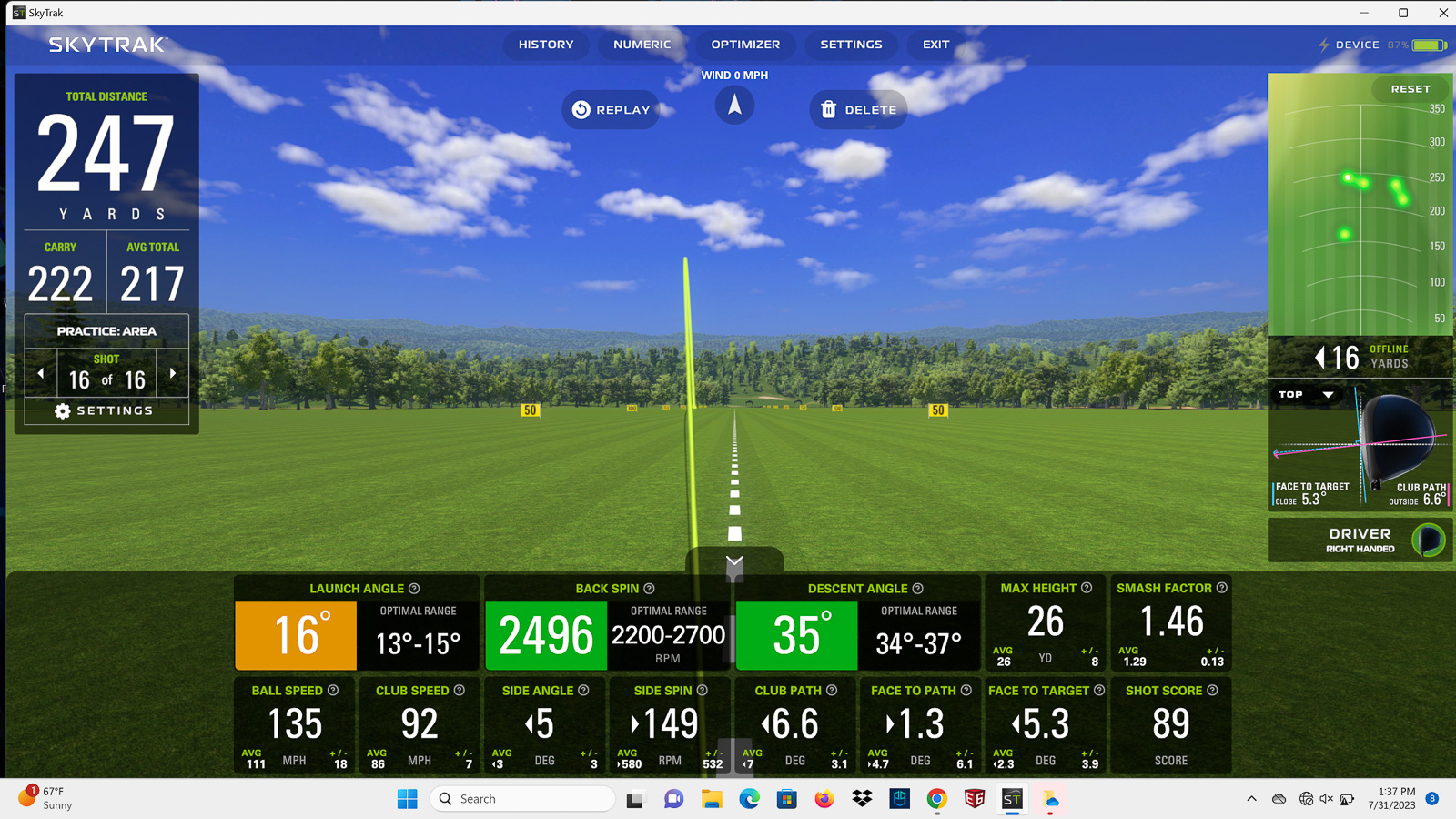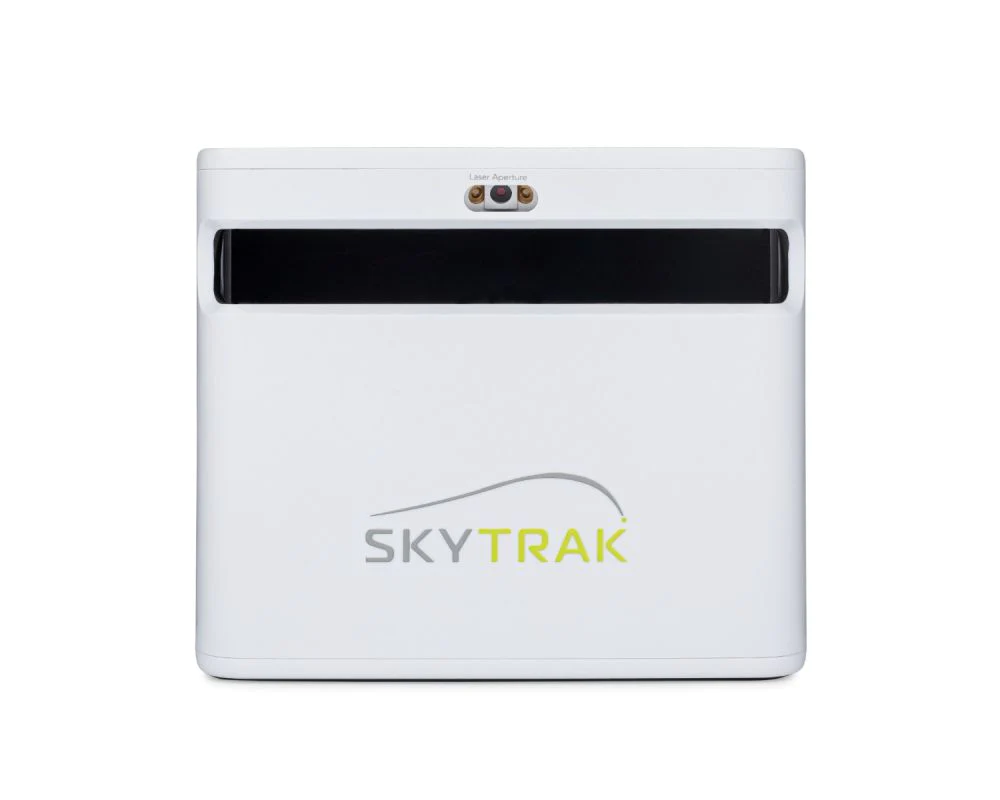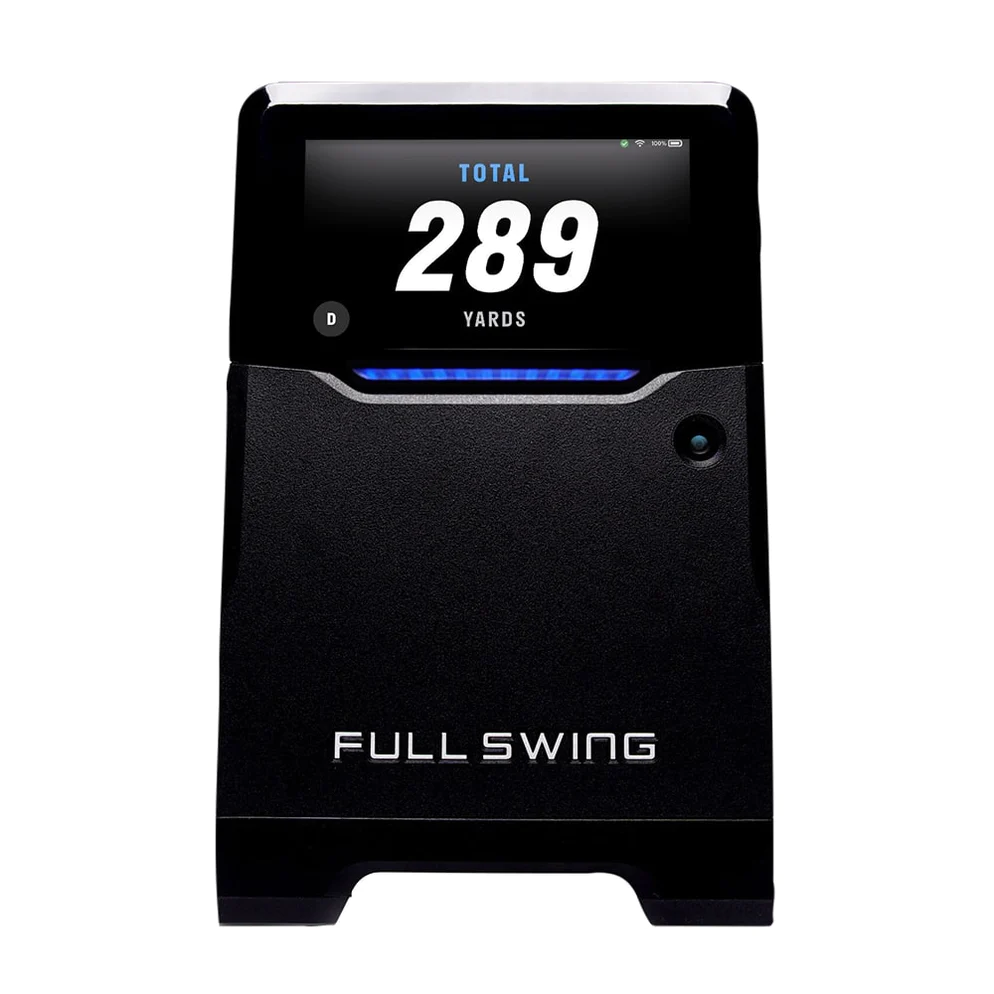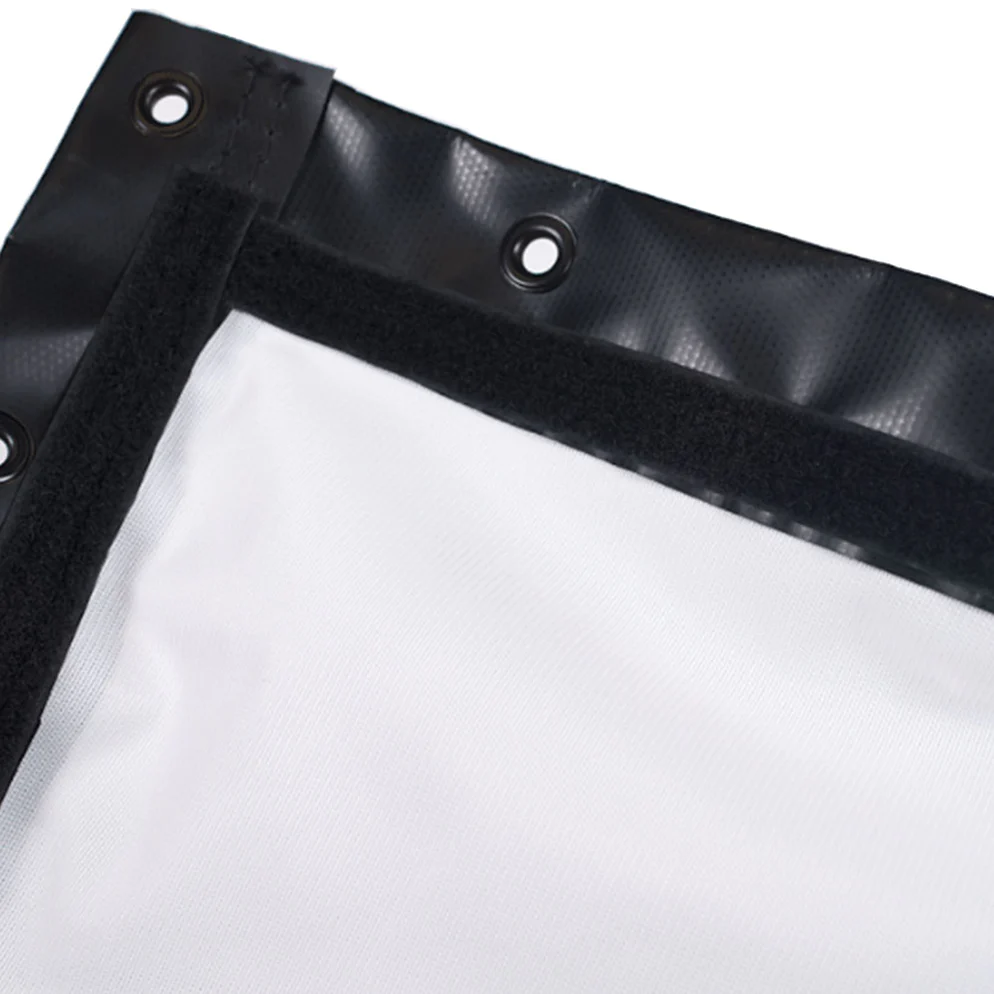If you’re a golf hardcore, you’ve without question dreamed of a home golf simulator setup.
I mean, is there anything cooler than the idea of being able to play golf without leaving your house?
And even if you’re a golf newcomer, mainstream exposure to simulators through places like Topgolf may have piqued your interest.
The thing is: There’s never been a better time to consider a golf simulator for your home.
Why?
Because golf simulators used to be totally cost-prohibitive. They were the stuff of dreams, not reality, for most of us.
Not anymore.
We’re going to show you that budget is no longer the main consideration for an at-home golf simulator.
Of course, price is still a factor. But with some saving, a lot of golfers can now realistically consider a home golf simulator. In fact, we’ll show you how you can get set up at home for not much more than $500.
More than cost, the main barrier to entry for a golf simulator at home is space. Understanding how much of it you’ll need can be confusing. We’re going to simplify it for you.
It’s completely overwhelming to consider each and every home setup variable at once. The point of this guide is to pare down the insane amount of information you’ll find on the internet to give you your best choices along with the answers to your most likely questions.
It’s kind of crazy to think about, but you could be hitting golf shots in your house in like a week.
Here’s everything you need to know.
WHAT IS A GOLF SIMULATOR?
Simply put, a golf simulator is a device that simulates an actual round of golf.
It’s like a golf video game, but you actually swing your real clubs and hit real golf balls.
A simulator usually pairs with a computer and oftentimes with a projector. You hit shots into a screen or net. The simulator tracks your swing and ball flight and gives you a virtual display of where the ball is flying and where on the golf course it landed.
Many simulators include virtual access to some of the most famous golf courses in the world.
So, from the comfort of your home, you can actually see and play the layout and yardages of St. Andrews, for example.
Granted, if you land in one of the pot bunkers, you’ll still be hitting your simulated shot off of a mat. And a lot of simulators do not replicate the putting experience very well (or at all).
Still, it’s pretty damn next level to be able to get up off your couch, fire up the simulator, call up Pebble Beach and decide what club you’re going to hit on the famous par 3 seventh. And to then actually hit the shot, watch the ball fly through the air towards the Pacific Ocean and then land, hopefully on that iconic green… For a golf junkie, it’s a totally wild experience.
GOLF SIMULATOR VS. GOLF LAUNCH MONITOR
A golf launch monitor is a doppler radar or camera-based device that measures various metrics about your golf shots.
A simulator, on the other hand, is an entire system that both measures swing metrics and simulates your ball flight in a virtual environment. Basically, a launch monitor is one component to a simulator system
Launch monitors can be used indoors or outdoors, but are often used at the driving range by golfers looking to use data to help them improve.
Simulators can also be used indoors or outdoors, but are often used indoors for both entertainment and game improvement.
Some devices, like the Garmin Approach R10 or FlightScope Mevo Plus are both a golf simulator and golf launch monitor.
Related: Flightscope Mevo Plus vs. Garmin R10: Which is Better?
And most launch monitors can pair with a computer and software to create a simulator setup.
If you’re looking for dedicated launch monitors, check out our picks for the eight best golf launch monitors on the market.
GOLF SIMULATOR FOR HOME SPACE REQUIREMENTS
As we said, space is the single biggest factor when considering if a golf simulator is going to be an option for you.
So, how much space do you need? Well, it depends…
To do this with complete comfort and confidence and to be able to accommodate both left- and right-handed golfers as well as tall golfers with one setup, we recommend a room that is at least:
- 10 feet high
- 15 feet wide
- 16 feet deep
Now, you can get away with less space than this.
Some radar-based simulators operate from behind you and will require that 16-foot depth in order to accurately track your ball flight. Other photometric simulators are set up to the side or mounted above and therefore don’t require as much depth.
Some swings are steeper while others are flatter. Steeper swings require higher ceilings.
A tall golfer with a steep swing will likely require even more than 10 feet of ceiling height. A shorter golfer, on the other hand, might be able to operate with only 8-foot ceilings.
If you’ve got friends or family that are both right- and left-handed, having that 15 feet of width would allow you a wide enough space to swing from either side without hitting the wall. If you only plan to host righties or lefties, you can probably get away with 9 feet of width.
There may be no bigger buzzkill than to buy a simulator, set it up and then realize the space you have is too small.
I learned this lesson the hard way years ago when I reviewed the Optishot 2 simulator. I set it up in my living room, invited some friends over, and within 15 minutes I’d put a hole in my ceiling (true story).
So, obviously, measure well. And swing your driver (slowly at first!) in the space before you buy anything.
WHAT MATERIALS DO YOU NEED FOR A DIY GOLF SIMULATOR?
To start bombing drives down the Road Hole from your garage, basement or living room, you’re going to need the appropriate space, a hitting mat, a net or impact screen, a golf simulator, a computer and possibly a projector.
At the end of this guide, we’ve included a list of our recommended mat, net and screen options.
Computer
Almost every proper golf simulator will require a computer to run its software. Devices like the R10 and Mevo Plus give you access to an iPad app that can run simulator software, but to get the full experience, you’ll likely need/want a dedicated computer.
You may already have a laptop, desktop or tablet capable of doing the job. It’s important that you check the specs of the simulator you choose to see if what you have will be robust enough.
If you can swing it, it would be ideal to have a dedicated computer for your simulator setup. Something that isn’t going to get slowed down with a lot of other software and files.
A dedicated gaming computer is the ultimate solution. Some simulator software includes 4K graphics, and you may need a powerful processor to keep up.
So, when you consider your overall budget, don’t forget to factor in the cost of a computer. Maybe you already own something that will work. If not, you likely will need to spend anywhere between $500 and $3,000 in addition to what you spend on a simulator, mat, and net or screen.
Do You Need a Projector?
So, you do not actually need a projector to pull off an at-home golf simulator setup.
But you might want one.
Why?
Because if you want to actually simulate what it would be like to play golf outdoors, you’re going to want to watch your ball fly through the air in front of you. To do that, you need an image projected onto an impact screen that won’t tear or dent when you pelt it with golf balls.
This means that you’ll be able to see where you’re hitting, just as you would if you were on an actual golf course or driving range.
Alternatively, you could just watch the action on your computer screen, or on a TV.
But obviously, you’re not going to hit balls into your computer screen or TV. So that would mean setting up that kind of display somewhere to the side. So, you’d hit your shot into a net, and then instead of looking ahead of you to see where the ball is going, you’d turn to the side to watch.
That’s not exactly ideal for a dream setup, but it does mean that you can save some money by not having to buy a projector or impact screen.
Personally, I think having a projector and impact screen makes all the difference. This is what’s going to separate a setup that will be pretty cool from one that will be totally mind-blowing and addictive.
If it’s me, I’m saving until I can step up to the best golf simulator setup.
PROS AND CONS OF A GOLF SIMULATOR
By this point, the pros of owning a golf simulator should be obvious.
Basically, you’ll become the coolest human in your general area.
Seriously, if you were my friend, you’d now be a strong candidate for becoming my best friend.
We’re talking about playing golf in your house!
Hitting shots after the kids go to bed.
Peppering greens even when it’s pouring rain outside.
Working on your short game in the dead of winter.
Blasting colossal drives in your underwear in the middle of the night (or whatever other weird thing you might be into).
I mean, come on! It’s golf in your house! Does it get any better than that?!
As for cons…
The biggest issue is once again space. How much room can you sacrifice? What’s the spouse going to say?
Now, depending on your setup, it is possible to collapse the net or screen, roll up the mat and stow away the computer and simulator. That’s actually a totally doable chore, and not necessarily a big deal.
So, you do have the option of not having to leave everything set up all the time.
Then again, it’s awfully nice to be able to walk in the door, turn on the system and start playing a round without the rigamarole of setting everything up.
And of course, cost can be a con. Again, with the introduction of devices like the Garmin Approach R10 (a simulator and launch monitor that retails for only $599.99) or the OptiShot 2 (a more basic setup that costs just $449.00), you can get going without a massive investment.
But if you want to reach toward the best golf simulator setup, you’re going to want a dedicated computer, a projector, an impact screen and the best hitting mat. When you throw in all of the components, it can start to get pretty pricey.
So while space, cost, and spousal considerations may be significant hurdles to clear, beyond those I can’t think of a whole lot of downside.
Oh yeah, one more potential con… Do you want to turn your house into a destination? Because your golf buddies might overstay their welcome.
BEST GOLF SIMULATOR UNDER $1,000: GARMIN APPROACH R10
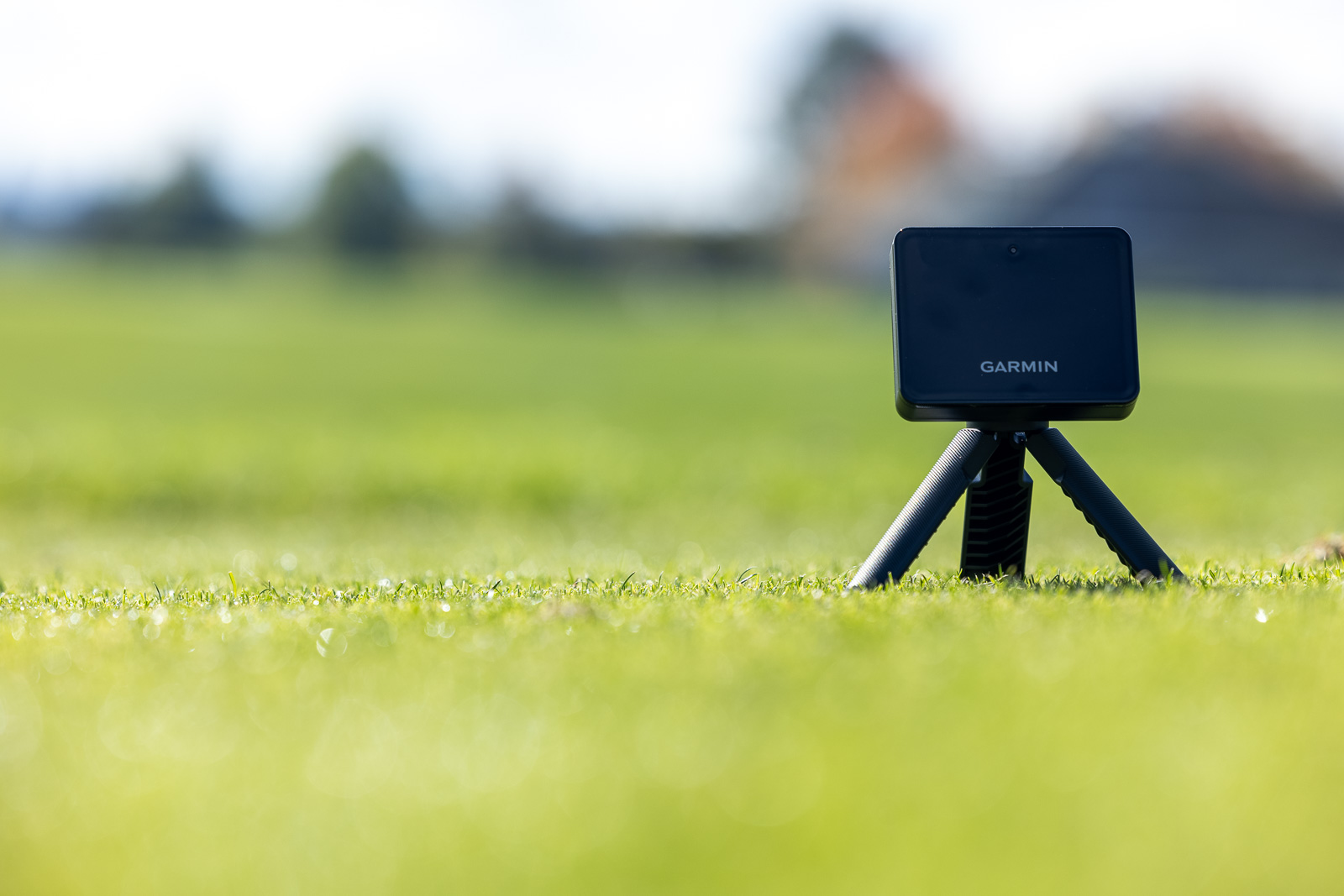
We said it before, and we’ll say it again: Cost is no longer the biggest barrier to entry for home golf simulators.
That wasn’t always the case.
In fact, until very recently, cost was without question the leading factor that made golf simulators an impossibility for most people.
Introducing the Garmin Approach R10. For $599.99, you can get a totally badass golf simulator that can also be used at the range as a dedicated golf launch monitor.
If you know, you know. This thing is mind-blowing.
And if you don’t know, you’re gonna have to trust us. Or don’t. Just go online, and read what everyone in the world is saying. The R10 was the hottest golf product of 2022. So much so that it’s been nearly impossible for retailers to keep in stock. The good news, is this is easing now, and the R10 is more accessible.
Using Garmin’s Home Tee Hero, which does require a $100-per-year subscription, you can select literally any golf course in the world and play it at home.
Now, Home Tee Hero is not a full-blown simulator software in that it gives you an animated overhead view of the hole rather than more lifelike, granular detail of each aspect of the hole.
But I gotta say, I dialed up my home course and was shocked to find that I was hitting the same shots in the app that I’d be hitting on the actual course.
The yardages, the layouts, the hazards… Everything was totally accurate.
You can play with up to four people. It also allows you to turn chip shots on or off. And it calculates your number of putts based on how close you are to the center of the green.
The Approach R10 is also compatible with TruGolf e6 Connect, which is one of the most well-known simulator software companies. They have dozens of courses mapped out, and many of the best simulators in the world use their software.
When you buy the R10, you get limited access to their iOS app, which allows you to play a full-on, 3D, simulated round of golf using a mobile device.
The R10 even comes with a demo package with five courses that includes Bandon Dunes.
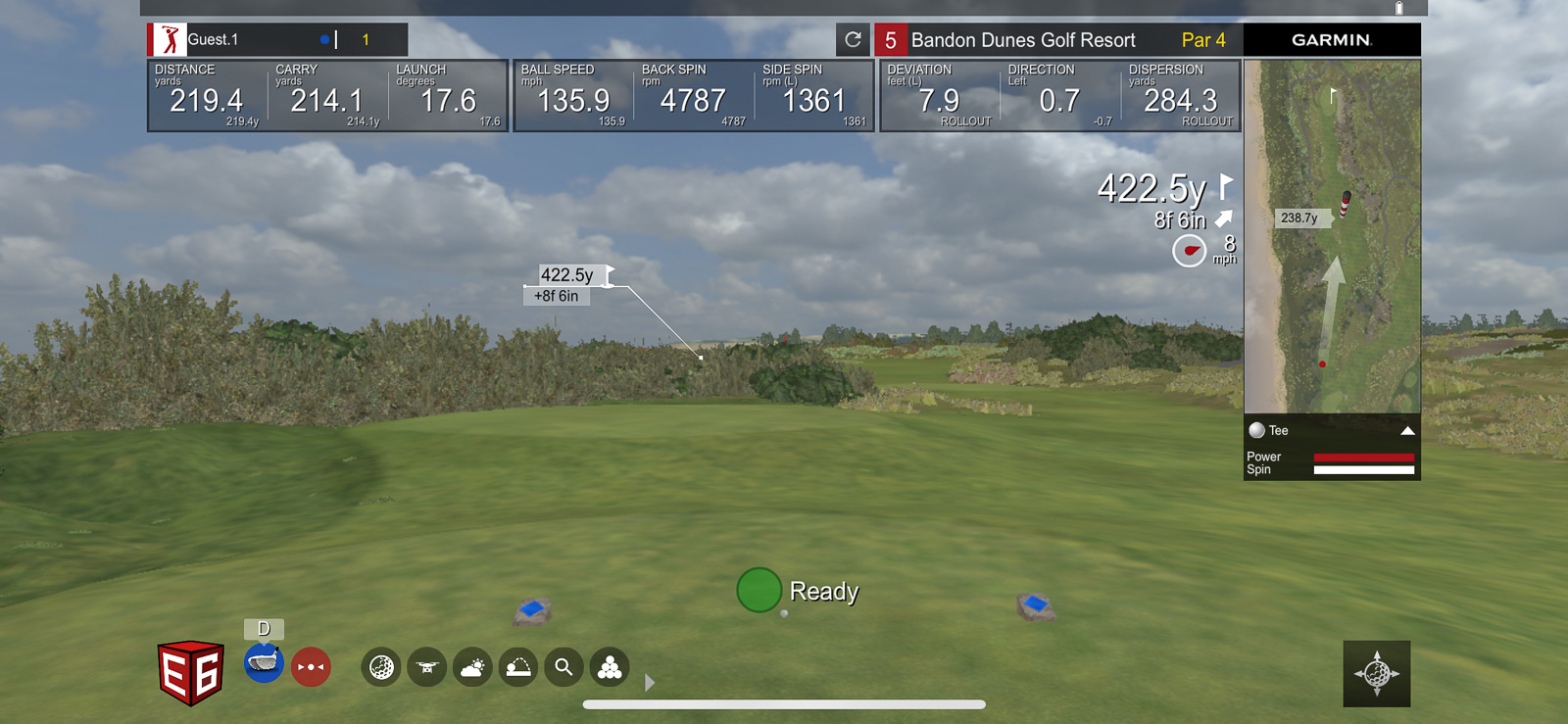
This e6 package is iOS only, so you won’t be able to hook it up to your PC. So you’ll need to look closely to find a projector that is compatible with an iPad.
Bottom line: If you can get your hands on an Approach R10, do it. Not only is it the best golf simulator for under $1,000, it’s also the best launch monitor for under $1,000. No other product can match that combination.
The Garmin Approach R10 is hands down one of the very best launch monitors you'll find for under $1,000. Highly recommend.
Best Golf Simulator Under $1,000 Runner-Up: Optishot 2
We said at the outset that you could install an at home golf simulator for not much more than $500.
Here’s how you do it:
Buy the OptiShot 2 for $449, buy a budget golf net (you can find ones that will do the job for $100 or less), and you’re set!
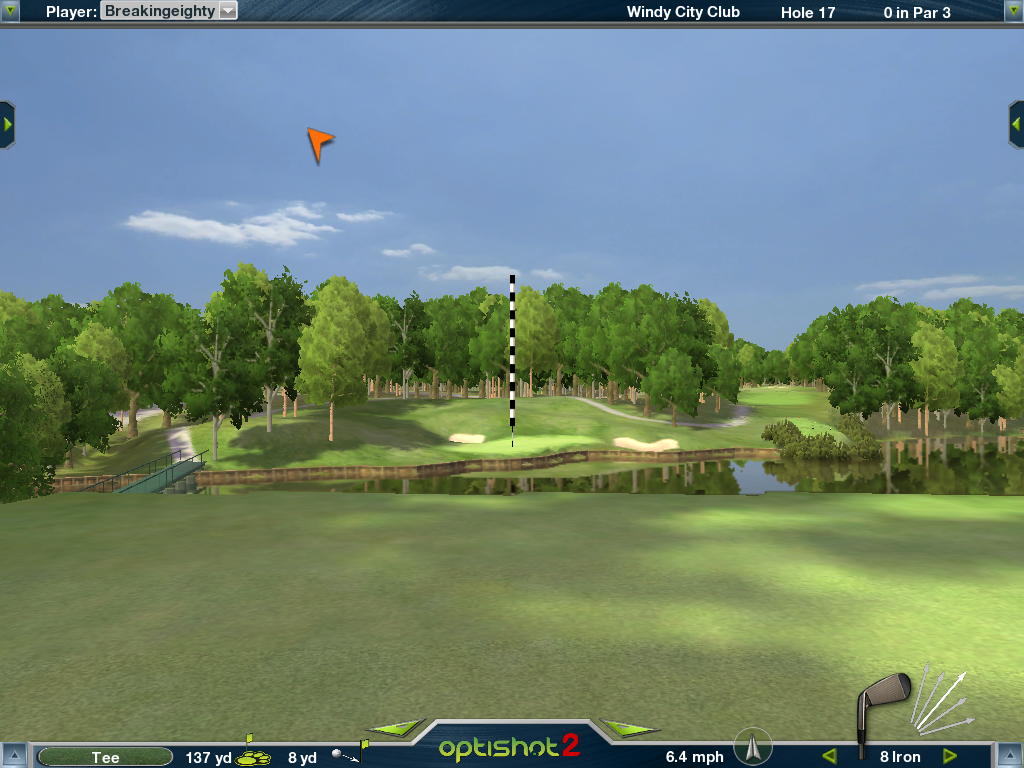
Assuming you have the space and a computer, that’s all you need to play golf in your house!
That basic setup doesn’t include a mat to stand on, but the OptiShot 2 does include the mat you’ll use to hit your shots.
And this setup doesn’t include a projector, which means you’ll have to watch your ball flight on a computer display, or perhaps use HDMI to watch it through a TV.
So it might not be the best golf simulator setup, but you’ll be hitting golf shots in your house.
Let’s take a look at what the Optishot 2 is, and just as importantly, what it is not.
This is a golf simulator that lets you play full rounds on digital versions of real courses (with changed names due to licensing purposes). It also has built-in swing tracking capabilities that are gauged by two sets of infrared sensors that are on the hitting mat.
The Optishot 2 is not measuring the ball. It’s measuring the club. When it passes over the sensors, the rays bounce off the club and give you a reading that is then expanded to give you relatively accurate results.
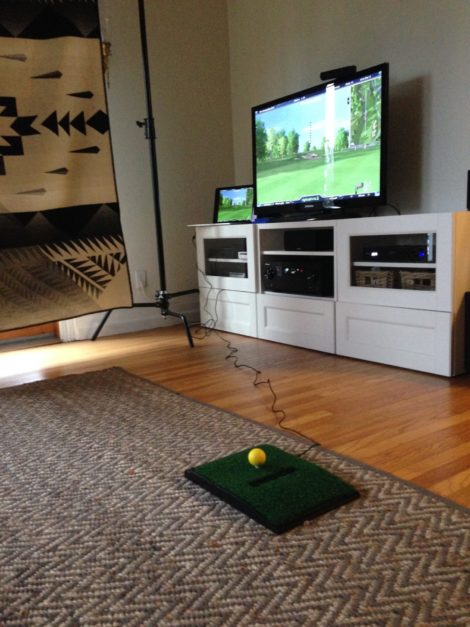
The good news is that because the sensors are in the hitting mat, you don’t need the extra depth that you would with simulators that are placed several feet behind the ball.
The bad news is that accuracy can get a bit spotty at times, especially compared to higher-end golf simulators. Also, putting is a bit iffy as it is with many golf simulators. But you can set the Optishot 2 up so that anything within a certain range is a gimme.
It comes preloaded with 15 golf courses, including Torrey Pines North and South and Bethpage Black. For another $29.95 per course, you can buy a bunch of other big-name courses. To me, that’s a bit steep for an a la carte course menu.
One really handy feature is that you can make any course a par 3 course. So, if you don’t have the ceiling height to accommodate your driver but do have enough height for your irons, you can still play some golf.
The Optishot 2 isn’t the best golf simulator, and it doesn’t quite replace an actual on-course experience. But for $449.00, you can:
- Get your golf fix during the off-season
- Play rounds on famous courses with friends on a Friday night
- Practice when you can’t get to the driving range
Again, we’re talking about golf in your house. There’s not a lot that sucks about that.
This might be the most affordable way to get a true golf simulator experience at home. It won't be as accurate as much more expensive models, but considering the price, it does everything I'd hoped it would.
BEST GOLF SIMULATOR UNDER $5,000
If you can reach this price range, the options start to open up. Here are four of the best golf simulators for under $5,000.
FlightScope Mevo+: Our Overall Pick for Best Launch Monitor
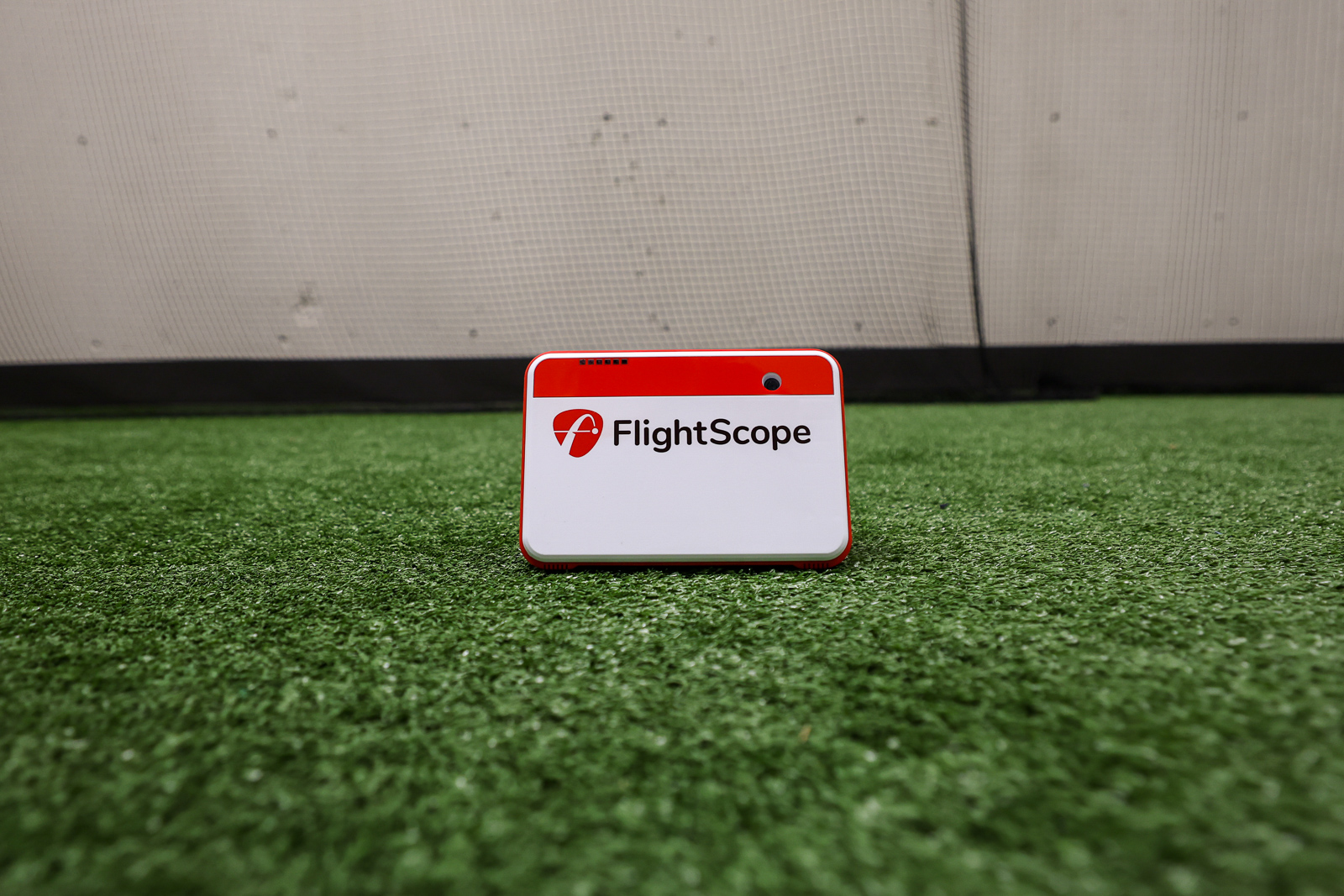
While this product, priced at $1,999, is most often marketed and used as an outdoor launch monitor, it does come with a mobile subscription to the e6 simulator software. That means that you can pair it with a mobile device to achieve a simulator setup.
The bummer is that the included e6 software won’t work with your PC, and therefore won’t be an option for a projector setup. For that, you’ll need to pay more.
Comparing the FlightScope Mevo+ to the Garmin Approach R10, the R10 won’t track putts, but the Mevo+ will. So if you want to play a full round of golf, including putts, the Mevo+ will be your better option.
Where the Mevo+ really stands out is with its super accurate tracking and with the full range of swing data it gives you for such a great value.
The base model Mevo+ has 16 different data sets. For $1,000 more, the Pro Package delivers a data set that will cost you more than $10K to find in any other device.
But those things may be more important for launch monitor functionality than for simulator functionality.
So, do you want one of the very best launch monitors that can also work as a mobile simulator? If so, the FlightScope Mevo+ will be tough to beat.
Now that this is in full "close out" mode, we're seeing by far the cheapest prices ever on it. It's still very capable and a killer deal.
Use code "BREAKINGEIGHTYPLUS" to get an additional 5% off!
Bushnell Launch Pro: Our Overall Pick for Best Home Simulator
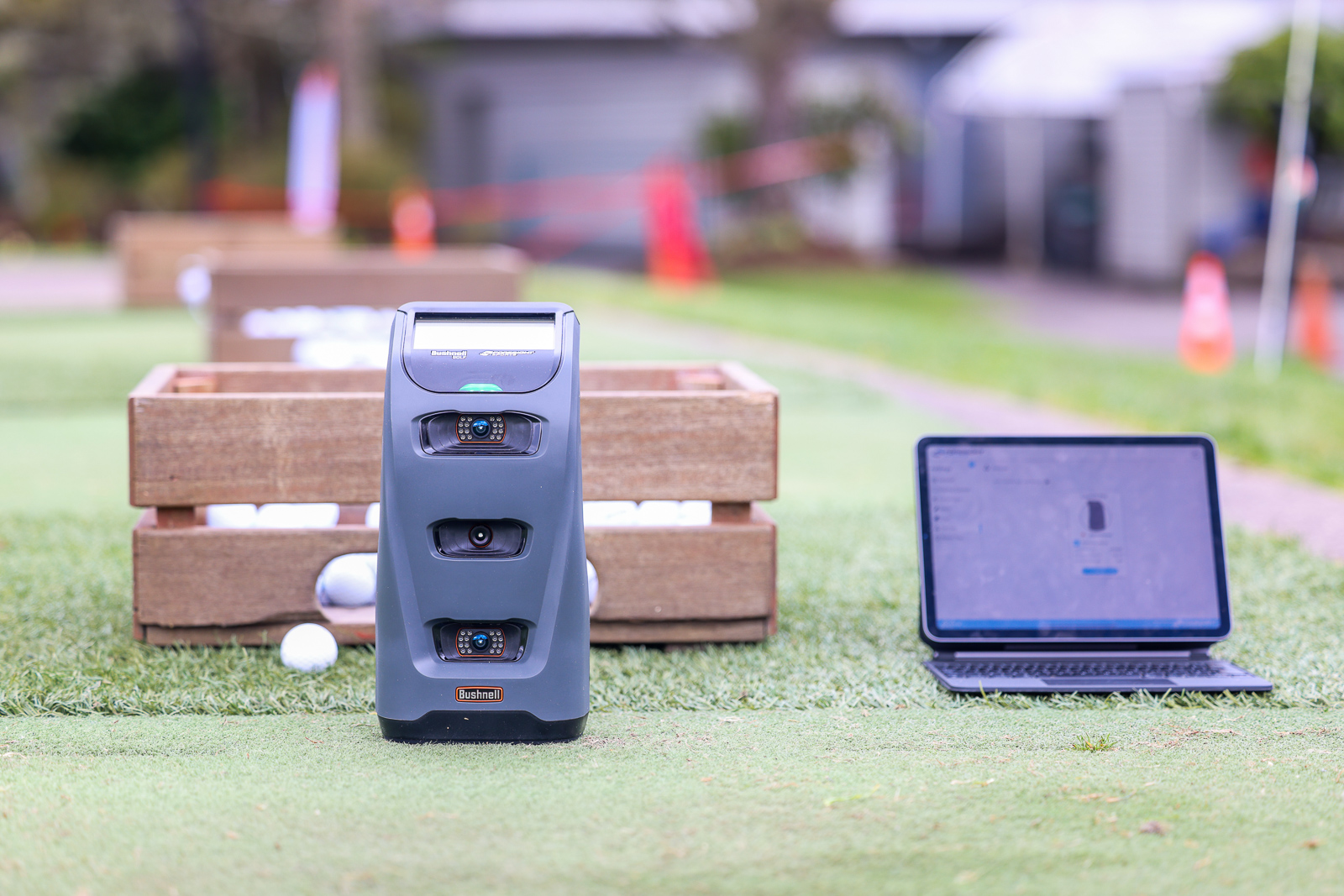
This is a serious, heavy-duty professional launch monitor that retails for $3,999. It’s the most accurate launch monitor I’ve ever reviewed.
And depending on which subscription package you get with the Launch Pro, you get access to a variety of simulator courses and experiences.
But unlike the Mevo+ or Approach R10, this device does not come with any simulator options that are mobile-compatible. So you’ll need a dedicated space in your house and a dedicated gaming PC to run it.
If you can get past those hurdles, you’ll get a launch monitor that can be used as a professional-grade at-home golf simulator.
One nice thing about the Launch Pro is that it measures from the side of the golf ball, rather than from behind. That means that you can get away with less overall depth in your setup.
If accuracy is the most important variable in your decision-making, get the Bushnell Launch Pro, and buy with confidence. This thing even tracks putts accurately.
Honestly, if I had a friend who was serious about putting in a legitimate simulator at their house, but didn’t want to totally break the bank?
This would be my recommendation. The Launch Pro will be more accurate and take up less space than the Mevo Plus inside, it’s just going to cost you a bit more.
Built off the Foresight GC3, the Bushnell Launch Pro is the most accurate launch monitor we've tested. If you're looking for professional results for a fraction of a Trackman? Definitely consider the Launch Pro.
SkyTrak+: Another Fantastic Simulator Option
SkyTrak has long been a very popular indoor launch monitor and golf simulator choice.
Like the Launch Pro, the SkyTrak monitor is set up to the side, saving you depth space. That can be an important factor depending on the dimensions of your room.
One of the coolest things about the SkyTrak+ is it gives you multiple simulation options, including for iOS or PC. The device pairs with seven different simulation software providers. That means tons of options for golf courses, opportunities to play online with friends, 4K compatible graphics, the chance to compete in live tournaments and much more.
The newest model, the SkyTrak+ isn’t cheap at just shy of $2,995. But in our testing it’s hands down the most consumer-friendly golf simulator at this price point, and accuracy was even better than we expected.
If you’re looking for a dedicated home simulator solution that you don’t need or want to bring out to the driving range, this is a great one to consider.
If you're looking specifically for a home simulator that's easy to use, fun, and accurate? The SkyTrak+ may provide the very best experience out there for the money.
Full Swing KIT: The Tiger Woods Endorsed Launch Monitor
Another pro-level launch monitor that can be used as an at-home golf simulator is the Full Swing KIT, priced at $4,999.
Full Swing claims they built this device specifically for Tiger Woods. I’d say if it meets his standards, the rest of us should be satisfied with the thorough array of metrics this thing measures.
This is another device that pairs with the e6 Connect iOS mobile software. That means you’ll need an iPhone or iPad and won’t be able to hook this up to a projector.
With the Basic e6 subscription, you’ll get 27 courses for a subscription cost of $299 per year. The Expanded package gets you more than 100 courses, practice areas and mini-game options for an annual subscription of $599.
Check out our Full Swing KIT review.
The only launch monitor endorsed by Tiger Woods is one of the most user-friendly and enjoyable to use launch monitors on the market. Use code "BE10" to save 10% on the KIT at Playbetter.com
BEST GOLF SIMULATOR OVER $5,000
The sweet spot of this ultimate guide is in what might be termed “affordable.” That’s a relative term, of course. But once we get over $5,000, we start to creep back into that territory of feeling like home golf simulators are only for people with endless amounts of money.
So, we’ll spend less time in this category.
But, hey, maybe you’re a baller. If so, here’s a very quick recap of four of the very best (and most expensive) golf simulators.
Trackman: The Best of the Best
This is the crown jewel of launch monitors and simulators. It’s what you see all the PGA pros using on the driving range. And it’s probably what they have in their (very large) houses.
Because that’s the thing: If you’re going to use a Trackman in your house, you’re going to need a lot of space. The Trackman uses radar to track the golf ball, and so it requires 9 feet behind the golfer and 15 feet in front of the golfer, meaning you’d need a room with a depth of at least 24 feet. That’s going to be a deal-breaker for many.
And if that doesn’t get you, the price probably will. Trackman’s website advertises simulator solutions starting at $45,490. Is that all?!
But, hey, if you want the absolute best, Trackman is the top of the line.
Foresight Sports GC3: Similar to the Launch Pro
The GC3 is actually the same device as the Bushnell Launch Pro. Same exceptional accuracy based on three very high-tech cameras. Same convenience of being able to set it up to the side to save on depth.
So, why does the GC3 cost $7,500 compared to the $3,999 price of the Launch Pro? It’s because the GC3 is an all-inclusive package that requires no subscriptions. You get access to all of the metrics the device is capable of registering, as well as lifetime access to the FSX 2020 Simulator software, which gets you 10 simulated courses.
The Launch Pro, on the other hand, is a subscription model.
With the recent price increase of the Bushnell Launch Pro, there’s no longer quite as obvious of an advantage when compared to the GC3. But either one of these will be excellent for a home simulator.
Foresight Sports GCQuad: The Premium Foresight Experience
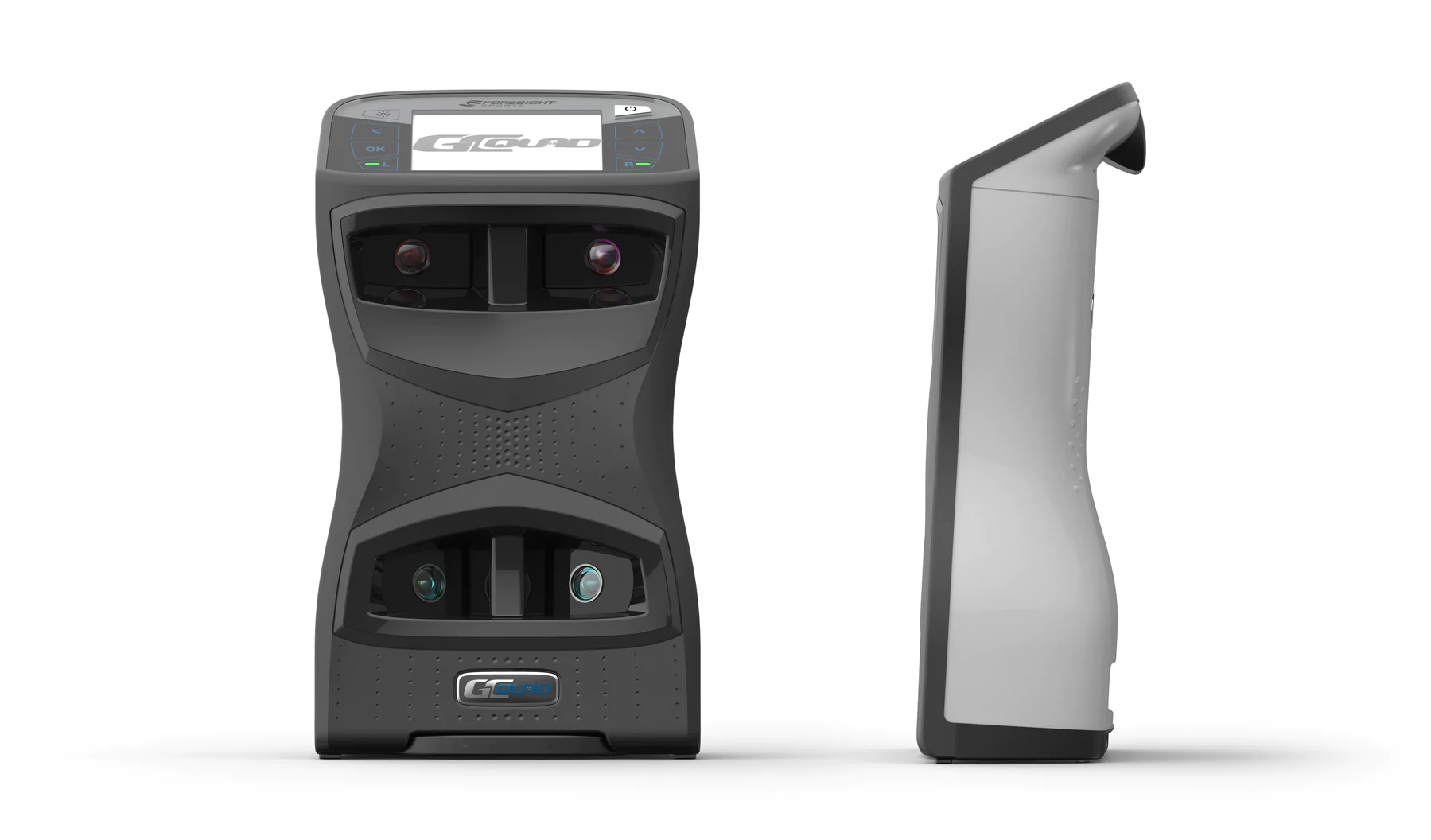
The GCquad is a very legitimate candidate for the best golf simulator. Of course, you’ve got to have a budget of almost $20K.
This is a camera-based launch monitor that, you may have guessed, uses four cameras instead of the three found in the GC3. That means, of course, even better accuracy, which is why this is the top pick of many club fitters and teaching pros.
Basically, you get every single piece of data you could possibly want to know about your golf swing. For most of us, it’s likely data overload.
The unit itself starts at $11,000. The FSX software will run you another $3,000. And if you want the full clubhead measurement capabilities, that will cost another $4,000.
Uneekor
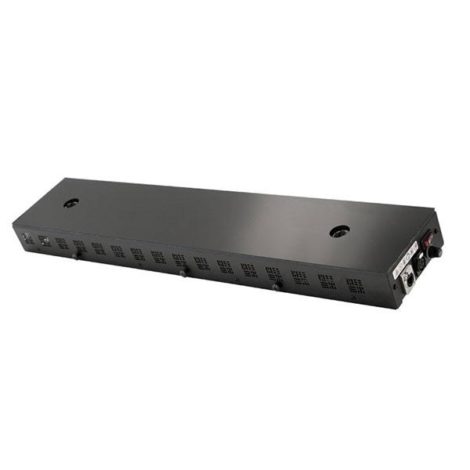
Uneekor uses a combination of infrared technology and high-speed cameras to record club and ball data. Beyond basic metrics like distance, launch angle, ball speed and spin rates, you’ll get a lot of swing path and clubface data as well. You can even watch slow-motion video of your club at impact.
One of the coolest things about this simulator setup is that the launch monitor mounts to the ceiling. That frees up a lot of space behind and to the side of where you’re hitting. But Uneekor does require a ceiling height between 9 and 10.5 feet.
The basic Uneekor launch monitor — the QED bar — starts at $7,000. While the EYE XO — which measures even more data points — starts at $10,000.
From there, you’ve got software costs to get the driving range and golf course simulation options. That will add another $1,000 to $2,000 to your out-the-door price.
Also because of the nature of the ceiling-mounted device, if you’re going this route you’re really going to need a dedicated space where you can leave your simulator setup.
Although, this is probably going to be the case for any of the devices mentioned in this over $5k category.
If you like the idea of a Uneekor model, but don’t want or need an overhead unit, you might consider the Eye Mini or the Eye Mini Lite.
GOLF SIMULATOR BUYING LIST
As you can tell, there’s no “one-size-fits-all” when it comes to setting up your home golf simulatory.
But let’s assume for a second if you’re still reading this article that you’re not going to drop tens of thousands on a professionally installed Trackman setup.
If you’re on a bit of a budget, and looking to get your golf fix at home in basement, spare room, or garage – then there are some essentials you’ll need.
In this section, I’ll outline a handful of products worth considering as you built out your DIY golf simulator.
Launch Monitor
This is the crux of your home golf simulator, and deciding which one is best for you will be the biggest factor that dictates your simulator experience. We’ve covered this in depth throughout this article, so hopefully you have a good sense of what is best four you.
Computer/Projector
These are both very personal choices based on your needs, space, and budget. So we’re not going to make recommendations for this one.
Golf Net
There are a ton of different nets out there, and this is another one where recommendations can vary based on your needs and available space.
But the GoSports 10×7 foot net is a great starting point. You can use it indoors or outdoors. Just remember if you’re looking for true “simulator experience” you’ll want to get an impact screen rather than a standard golf net.
There are a ton of different hitting net options out there, but this one is sturdy, has multiple size options, and won't break the bank.
Impact Screen
If you’re planning to use a projector and want a true simulator experience, then you’ll want to forgo the net and pick up an impact screen. The SIG Preferred screens you can get from Play Better, are high quality and allow you to customize size and dimensions based on your needs.
SIG Preferred has high-quality impact screens that you can get cut to different sizes and dimensions based on your space requirements.
Golf Mat
These come in various shapes and sizes, and range from under $100 to into the thousands depending on what you want. For a basic setup, we recommend this 5×5 foot mat from GoSports. It’s big enough that you’ll be able to stand on it while hitting, has space for tees, and is super affordable.
If you're looking for a high quality golf mat, the mats from GoSports will do a great job. They don't have extra features like multiple turf types, but for a basic practice setup? This is a great choice.
HOME GOLF SIMULATOR FAQs
We’ve hopefully answered the questions you may have had about golf simulators. But let’s recap a few of the commonly asked questions.
How much does a golf simulator cost?
Our recommended golf simulators range in price from $449 to more than $45,000. How’s that for a price range? The good news: There’s something for just about every golfer who has the space to accommodate a home golf simulator.
Is buying a golf simulator worth it?
You better believe it’s worth it! That is, if you like golf, fun, convenience, comfort and being the coolest person in your circle of friends. Other than that, it’s a total rip off.
What size room do you need for a golf simulator?
To accommodate all different heights, lefties and righties and every different kind of simulator setup, we recommend a minimum room size of:
- 10 feet high
- 15 feet wide
- 16 feet deep
Why are golf simulators so expensive?
There’s a lot of R&D and technology packed into these systems, which of course costs these companies a lot of money. But prices are coming down. Golf simulators are becoming more accessible to more people. Our pick for the best golf simulator under $1,000 — the Garmin Approach R10 at $599.99 — is the perfect example.
Are home golf simulators accurate?
For the most part, you can expect outstanding accuracy with today’s home golf simulators. A less-expensive system like the Optishot 2 is going to misread a club or ball flight on occasion, and some monitors will be off by a few yards. But for most non-tour-pro golfers, the accuracy of these modern systems is unbelievable.
GOLF SIMULATOR ULTIMATE GUIDE: IT’S A WRAP
Phew… That’s a lot of hopefully very useful information.
The thing about golf simulators is that it’s very easy to get total information overload when you start looking around the internet. Frankly, it gets confusing.
So, while this might be a lot of information, the hope is that this guide gets down to the essentials. You should now have a solid handle on what a golf simulator setup includes, what kind of space it requires, what you’ll need to achieve a full setup, what you can expect to pay and which golf simulators are worth your consideration.
Whether you want to sharpen your game in the offseason, entertain your friends, introduce your kids to golf or just add some awesome technology to your home, I can think of a lot of worse ways to spend your money than on a golf simulator.
This page contains affiliate links. This means that if you click a link and buy one of the products on this page, I may receive a commission (at no extra cost to you!) This doesn’t affect our opinions or our reviews. Everything we do is to benefit you as the reader, so all of our reviews are as honest and unbiased as possible.
Recent Updates:
July 28th, 2025: Added video of my 10 favorite indoor launch monitors.
February 6th, 2025: Updated dates to reflect 2025. Added links to reviews for golf hitting mats, Uneekor Eye Mini, and Uneekor Eye Mini Lite.


